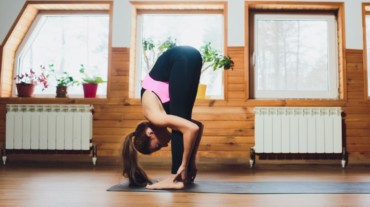
Surya Namaskar or sun salutation, which is a combination of 12 yoga poses, is widely known for its health benefits. Each pose has something to offer. One of them is Padahastasana or Hand to Foot Yoga Pose, which is an effective yoga asana practised to improve physical flexibility, stimulate the nervous system and more. Read on to know the benefits of Padahastasana.
Padahastasana is a yoga asana that involves a forward bending posture. The name “Padahastasana” is derived from the Sanskrit words “pada,” meaning foot, “hasta,” meaning hand, and “asana,” meaning pose, shares yoga and wellness coach Shivani Bajwa.

To do the forward bending yoga asana, follow these steps:
• Start with the mountain pose, with your feet hip-width apart and arms by your sides.
• Inhale as you lift both your arms overhead.
• Exhale and hinge at your hips, bending forward from the waist. Keep your spine straight as you fold forward.
• Bring your hands down to the floor on either side of your feet. If your hands don’t reach the floor, you can bend your knees slightly. Try to bring your palms flat to the ground, placing them beside your feet.
• If possible, straighten your legs, bringing your torso closer to your thighs. You may feel a stretch in your hamstrings and lower back.
• Hold the position for a few breaths, relaxing into the stretch.
• To release the pose, bend your knees slightly, engage your core, and slowly roll up to a standing position, one vertebra at a time.
Padahastasana targets many parts of the body, so it is a very beneficial asana. Here are some of the benefits:
Padahastasana involves a deep forward bend, which stretches and lengthens the muscles in the back of the legs, particularly the hamstrings and calves. This can help you to walk or run better.
The forward bending action helps to increase the flexibility of the spine, says the expert. This promotes better range of motion and reduces stiffness.
Engaging the core muscles in padahastasana helps to strengthen the abdominal muscles. This provides support to the spine and improves overall core stability.
The forward fold compresses the abdominal region, massaging and stimulating the organs in the digestive system. This can contribute to improved digestion, says Bajwa.
The inverted position of the head in this pose can have a calming effect on the nervous system. So, it can help to reduce stress and anxiety.

The forward bend promotes blood circulation to the head and face. This potentially improves oxygen supply to the brain and reduces feelings of lethargy.
Like many yoga poses, padahastasana requires concentration and mindfulness. Focusing on the breath and the sensations in the body during the pose can help to calm the mind and improve mental clarity.
The combination of physical movement, deep breathing and the inversion in padahastasana may contribute to mood enhancement. This may help to manage mild symptoms of depression, says the expert.
While padahastasana can offer various benefits, there are certain people who should avoid this pose due to specific health conditions or concerns. Here are some considerations for individuals who might need to avoid padahastasana:
People with existing back injuries, especially those involving the lower back, should be cautious with forward-bending poses like padahastasana. It might be more suitable to modify the pose by bending the knees or avoiding deep forward bends, suggests the expert.
Individuals with uncontrolled high blood pressure may need to be cautious with inversions, as the head is positioned below the heart in padahastasana.
Pregnant women, especially those in later stages of pregnancy, may find it uncomfortable or challenging to practice padahastasana. Modifications, such as keeping the knees bent, may be more suitable.
People who experience dizziness should be cautious with inversions. If these symptoms are a concern, it’s advisable to skip this yoga pose.
Anyone with osteoporosis or low bone density may need to be cautious with forward bends to prevent strain on the spine. Modifications, such as using props or keeping a slight bend in the knees, can be considered.
As with any exercise or yoga pose, it is essential to listen to your body and consult with a healthcare professional or a qualified yoga instructor if you have any doubts or pre-existing health issues.
Get Latest Updates on Fitness, Muscle Gain, Staying Fit, Weight Loss